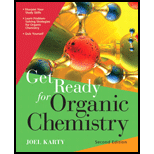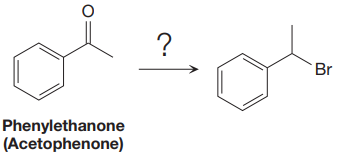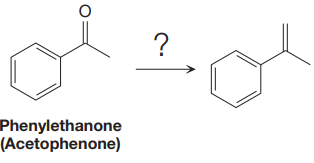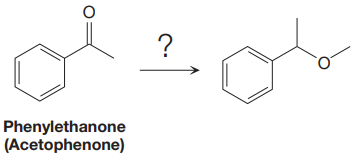
Concept explainers
(a)
Interpretation:
The synthesis of given compound from
Concept introduction:
In an
Answer to Problem 17.66P
The synthesis of given compound from

Explanation of Solution
The given reaction is,

The first step of the reaction is reduction of
The synthesis of given compound from

The synthesis of given compound from
(b)
Interpretation:
The synthesis of given compound from
Concept introduction:
The
Answer to Problem 17.66P
The synthesis of given compound from

Explanation of Solution
The given reaction is,

In the first a new C-C bond is formed and a methyl group is added to the carbonyl carbon. Both alkyllithium reagents and Grignard reagents can react rapidly with water in a substantially exothermic proton transfer reaction to produce an alkane and
The synthesis of given compound from

The synthesis of given compound from
(c)
Interpretation:
The synthesis of given compound from
Concept introduction:
In an
Answer to Problem 17.66P
The synthesis of given compound from

Explanation of Solution
The given reaction is,

The first step of the reaction is reduction of
The synthesis of given compound from

The synthesis of given compound from
Want to see more full solutions like this?
Chapter 17 Solutions
Get Ready for Organic Chemistry
- (SYN) Show how each of the following compounds can be synthesized from an acid chloride and either water, an alcohol, or an amine. For each reaction, provide the complete, detailed mechanism.arrow_forwardWhich reaction in each of the following pairs would you expect to be faster? (i) Write both reactions using bond-line presentation and, using arrows providing a mechanistic explanation of the course of the reaction, draw either a transition state or an intermediate product of the reaction; (ii) Shortly (one sentence) explain your reasoning why one of the two reactions will be faster.arrow_forwardGive detailed Solution with explanation needed..give answer both sub parts if you not then don't give answer..I will give you upvotearrow_forward
- (SYN) Show how to carry out each of the following syntheses, using any reagents necessary. Hint: In each case, the carbonyl group of a ketone or aldehyde is entirely removed. (a) (b) ? OCH3 OCH3 OCH3 OCH3 (c) (d) ? ? OH Pharrow_forwardGive detailed Solution with explanation neededarrow_forwardGive detailed mechanism Solution with explanation needed..don't give Handwritten answerarrow_forward
- (SYN) Show how to carry out each of the following syntheses by first converting the alcohol into a sulfonyl chloride.arrow_forward(SYN) Show how each of these compounds can be produced from an alkene or alkyne. Draw the appropriate alkene or alkyne and include any necessary reagents and special reaction conditions. (a) (b) (c) (d) ОН HOarrow_forward(SYN) After consulting Problem 18.52, suggest how the amidine shown here can be synthesized from benzonitrile, C6H5C=N. Hint: More than one synthetic step may be necessary. NH 'N' An amidinearrow_forward
- ) (SYN) Show how each of the following lithium dialkylcuprate reagents can be synthesized from an alkyl, alkenyl, alkynyl, or aryl halide. (a) (b) (c) (d) CULI CuLi CuLi CuLiarrow_forwardGive detailed mechanism with explanation neededarrow_forward(SYN) Suggest how you would synthesize each of the following compounds beginning with pentan-2-one. (а) OH OH (b) ОН (c) OHarrow_forward
 Organic Chemistry: A Guided InquiryChemistryISBN:9780618974122Author:Andrei StraumanisPublisher:Cengage Learning
Organic Chemistry: A Guided InquiryChemistryISBN:9780618974122Author:Andrei StraumanisPublisher:Cengage Learning
